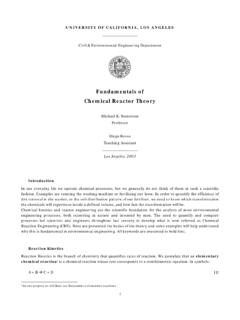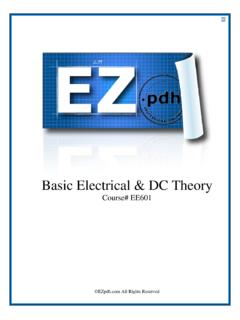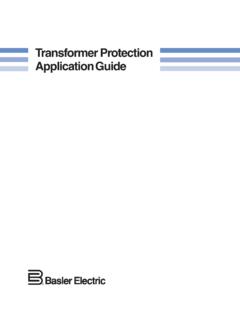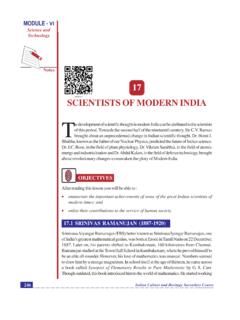Transcription of Air Pollution Control Technology Fact Sheet
1 EPA-452/F-03-022. Air Pollution Control Technology Fact Sheet Name of Technology : Thermal Incinerator This type of incinerator is also referred to as a direct flame incinerator, thermal oxidizer, or afterburner. However, the term afterburner is generally appropriate only to describe a thermal oxidizer used to Control gases coming from a process where combustion is incomplete. Type of Technology : Destruction by thermal oxidation Applicable Pollutants: Primarily volatile organic compounds (VOC). Some particulate matter (PM), commonly composed as soot (particles formed as a result of incomplete combustion of hydrocarbons (HC), coke, or carbon residue) will also be destroyed in various degrees.
2 Achievable Emission Limits/Reductions: VOC destruction efficiency depends upon design criteria ( , chamber temperature, residence time, inlet VOC concentration, compound type, and degree of mixing) (EPA, 1992). Typical thermal incinerator design efficiencies range from 98 to and above, depending on system requirements and characteristics of the contaminated stream (EPA, 1992; EPA, 1996a). The typical design conditions needed to meet 98% or greater Control or a 20 parts per million by volume (ppmv) compound exit concentration are: 870/C (1600/F).
3 Combustion temperature, second residence time, and proper mixing. For halogenated VOC streams, 1100/C (2000/F) combustion temperature, second residence time, and use of an acid gas scrubber on the outlet is recommended (EPA, 1992). For vent streams with VOC concentration below approximately 2000 ppmv, reaction rates decrease, maximum VOC destruction efficiency decreases, and an incinerator outlet VOC concentration of 20 ppmv, or lower may be achieved (EPA, 1992). Controlled emissions and/or efficiency test data for PM in incinerators are not generally available in the literature.
4 Emission factors for PM in phthalic anhydride processes with incinerators are available, however. The PM Control efficiencies for these processes were found to vary from 79 to 96% (EPA, 1998). In EPA's 1990 National Inventory, incinerators used as Control devices for PM were reported as achieving 25 to 99%. Control efficiency of particulate matter 10 microns or less in aerodynamic diameter (PM10) at point source facilities (EPA, 1998). Table 1 presents a breakdown of the PM10 Control efficiency ranges by industry for recuperative incinerators (EPA, 1996b).
5 The VOC Control efficiency reported for these devices ranged from 0 to These ranges of Control efficiencies are large because they include facilities that do not have VOC emissions and Control only PM, as well as facilities which have low PM emissions and are primarily concerned with controlling VOC (EPA, 1998). EPA-CICA Fact Sheet 1 Thermal Incinerator Table 1. Thermal Incinerator PM10 Destruction Efficiencies by Industry (EPA, 1996b). PM10 Control Industry/Types of Sources Efficiency (%). Petroleum and Coal Products 25 - asphalt roofing processes (blowing, felt saturation); mineral calcining; petroleum refinery processes (asphalt blowing, catalytic cracking, coke calcining, sludge converter); sulfur manufacturing Chemical and Allied Products 50 - carbon black manufacturing (mfg); charcoal mfg; liquid waste disposal; miscellaneous chemical mfg processes; pesticide mfg.
6 Phthalic anhydride mfg (xylene oxidation); plastics/synthetic organic fiber mfg; solid waste incineration (industrial). Primary Metals Industries 70 - by-product coke processes (coal unloading, oven charging and pushing, quenching); gray iron cupola and other miscellaneous processes; secondary aluminum processes (burning/drying, smelting furnace); secondary copper processes (scrap drying, scrap cupola, and miscellaneous processes); steel foundry miscellaneous processes; surface coating oven Electronic and Other Electric Equipment 70 - chemical mfg miscellaneous processes; electrical equipment bake furnace.
7 Fixed roof tank; mineral production miscellaneous processes; secondary aluminum roll/draw extruding; solid waste incineration (industrial). Electric, Gas, and Sanitary Services 90 - 98. internal combustion engines; solid waste incineration (industrial, commercial/ institutional). Stone, Clay, and Glass Products 50 - 95. barium processing kiln; coal cleaning thermal dryer; fabricated plastics machinery; wool fiberglass mfg Food and Kindred Products 70 - 98. charcoal processing, miscellaneous;. corn processing, miscellaneous, fugitive processing, miscellaneous.
8 Soybean processing, miscellaneous Mining 70 - asphalt concrete rotary dryer; organic chemical air oxidation units, sulfur production National Security and International Affairs 70. solid waste incineration (commercial/institutional and municipal). Textile Mill Products 88 - 95. plastics/synthetic organic fiber (miscellaneous processes). Industrial Machinery and Equipment 88 -98. secondary aluminum processes (burning/drying, smelt furnace). Lumber and Wood Products 70. solid waste incineration (industrial).
9 Transportation Equipment 70 - 95. solid waste incineration (industrial). EPA-CICA Fact Sheet 2 Thermal Incinerator Applicable Source Type: Point Typical Industrial Applications: Thermal incinerators can be used to reduce emissions from almost all VOC sources, including reactor vents, distillation vents, solvent operations, and operations performed in ovens, dryers, and kilns. They can handle minor fluctuations in flow, however, excess fluctuations require the use of a flare (EPA, 1992). Their fuel consumption is high, so thermal units are best suited for smaller process applications with moderate-to-high VOC loadings.
10 Incinerators are used to Control VOC from a wide variety of industrial processes, including, but not limited to the following (EPA, 1992): Storing and loading/unloading of petroleum products and other volatile organic liquids;. Vessel cleaning (rail tank cars and tank trucks, barges);. Process vents in the synthetic organic chemical manufacturing industry (SOCMI);. Paint manufacturing;. Rubber products and polymer manufacturing;. Plywood manufacturing;. Surface coating operations: Appliances, magnetic wire, automobiles, cans, metal coils, paper, film and foil, pressure sensitive tapes and labels, magnetic tape, fabric coating and printing, metal furniture, wood furniture, flatwood paneling, aircraft, miscellaneous metal products.















